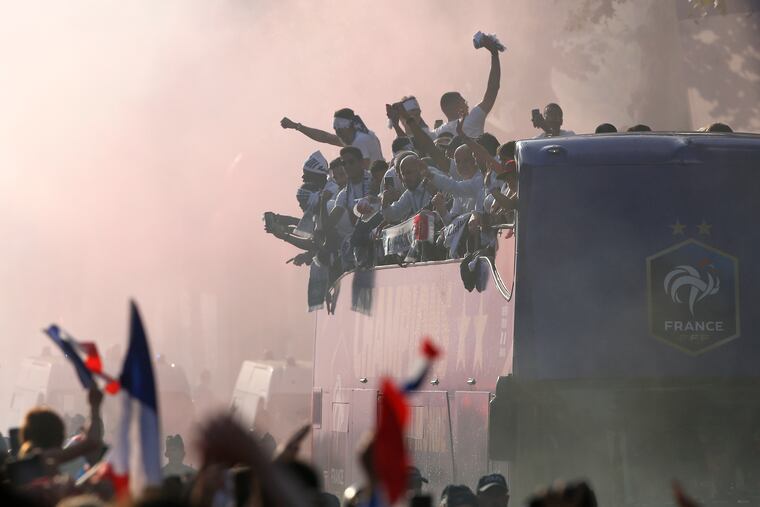Counterterrorism lessons from Paris, after this week’s World Cup celebrations | Opinion
Precautions are taken to better protect public spaces, to better use technology to monitor bad actors, and to help security forces and first responders work effectively together. But a spirit of resilience ensures that these security measures do not hamper everyday life.

PARIS — On the streets of Paris, police are breathing a sigh of relief.
The two-year anniversary of the Nice terrorist attack, when a man associated with the Islamic State killed 86 people and injured 434 by driving a truck into large crowds watching Bastille Day fireworks, passed without incident. This despite massive parades and public gatherings across France, in honor of last weekend's national holiday and the French soccer team's World Cup win.
For the hundreds of thousands celebrating in central Paris, the World Cup victory parade was a reminder of how a city and country can recover from a series of deadly terrorist attacks that have killed 246 people all told. For those watching from across the Atlantic, it provided lessons for how to effectively respond to the sorts of terrorist attacks that have become more and more common over the past three years.
First, the celebrations showcased protective measures that Paris, London, and other European cities are taking to better secure open spaces most vulnerable to terrorist attacks – the parks, town centers, pedestrian pathways, and public squares that are "soft targets" for car bombs or drivers intent on hitting pedestrians. Security perimeters have been extended around major tourist sites like the Eiffel Tower, limiting access and protecting these gathering spaces for pedestrians. When I walk into a park, I must now sidestep a metal bollard, large concrete flowerpots, or similar blockades, placed at the entrance to prevent a car from driving into the open spaces.
It's also hard to miss the CCTV cameras that, more and more, monitor passersby on any given street to detect suspicious behavior. Unmanned camera drones also conduct aerial surveillance at major public events, like the recent parade, scanning the crowd for bad actors and helping security officials track suspect activity as it unfolds.This use of advanced technology has become more commonplace in European cities.
>>READ MORE: Democrats are missing the opportunity to offer an alternative to endless war | Opinion
For example, the combination of CCTV, facial recognition technology, and big data analytics helped police to identify, capture, and recently prosecute a Taliban-linked Briton who was plotting an attack at government offices in central London. He was caught after a video feed spotted him performing reconnaissance while carrying three large knives.
Alongside these physical and technological measures, increased joint operations between local police and military forces are noticeable. For Bastille Day celebrations, 12,000 police and gendarmes were on duty around Paris, with an additional 2,000 soldiers deployed to the streets for Operation Sentinelle, the military's domestic security effort since the 2015 terrorist attacks struck Paris, including at a soccer stadium and a concert hall. And I wasn't surprised to hear that plans to further align military and civilian counterterrorism efforts were a key aspect of 32 new measures just announced by French Prime Minister Edouard Philippe.
But what happens when we apply these ideas in the United States? How can we physically harden public spaces, given the sheer geographic expanse of our major cities? While important, it will take years – and, ultimately, be impossible – to secure every large public gathering area and pedestrian spaces in our major cities.
>>READ MORE: You can stop the anti-American hate group behind the Florida massacre | Will Bunch
Technological fixes are likewise problematic. Even as our cities have started to expand the scope of surveillance efforts beyond visual monitoring, courts are still debating how the Fourth Amendment's protection against "unreasonable searches" should apply.
Improving collaboration between military and local police, and among federal, state, and city security forces, may be the biggest hurdle of all. The FBI now has Joint Terrorism Task Forces (JTTFs) in 104 cities nationwide, to enhance coordination among more than 500 state and local agencies and 55 federal agencies. But with almost 17,000 law enforcement agencies across the United States, continued focus on information-sharing and expanded joint training efforts remain critical – and there is no simple solution.
Which is why the most important lesson from Paris is something that's largely unspoken among the locals: Even as increased security efforts become the norm, daily life goes on largely unchanged. Public parties thrive. Parades – and, yes, protests – continue. No one stays home out of fear or security concern. Precautions are taken to better protect public spaces, to better use technology to monitor bad actors, and to help security forces and first responders work effectively together. But a spirit of resilience ensures that these security measures do not hamper everyday life. Or dampen special moments, like a spectacular World Cup celebration.
That's the best lesson of all.
Marisa Porges is head of school at the Baldwin School in Bryn Mawr and a former counterterrorism policy adviser in the Bush and Obama administrations.